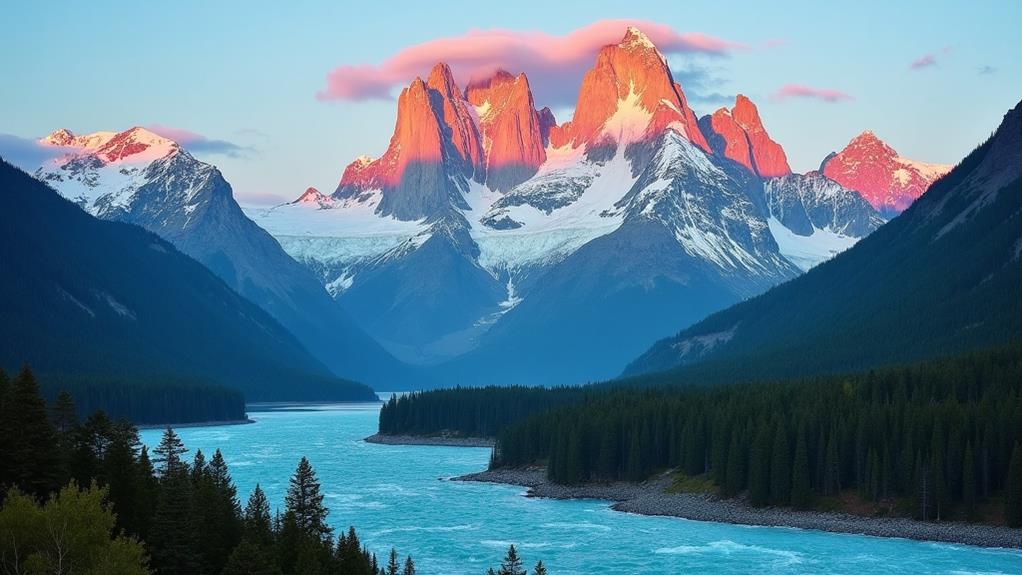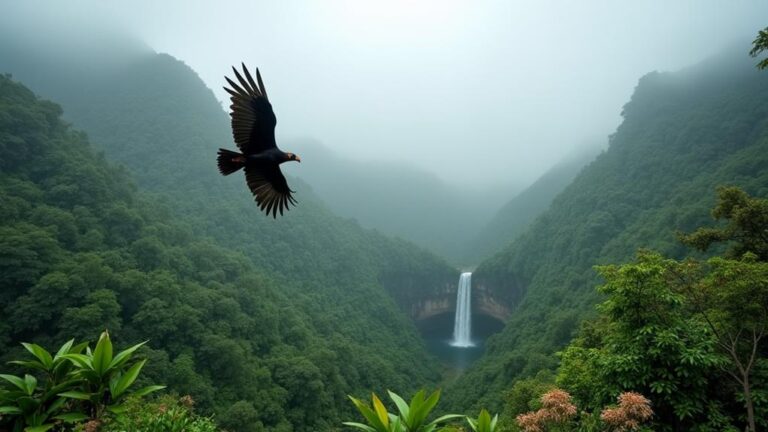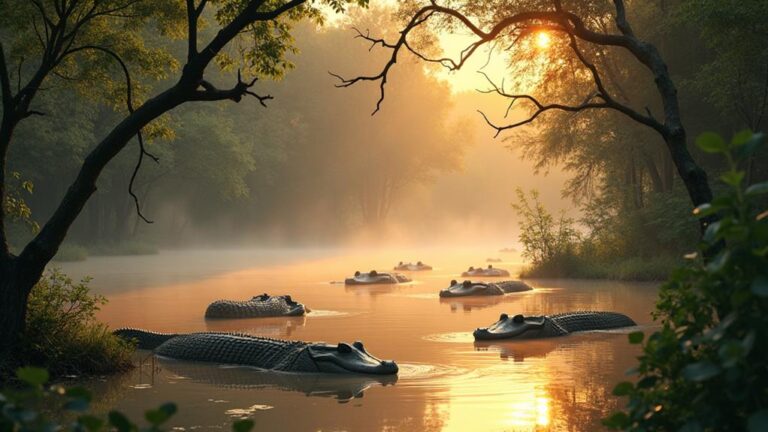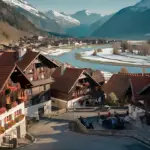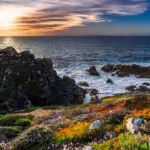As you venture into Patagonia Argentina, you'll find yourself surrounded by towering glaciers, majestic mountains, and untouched wilderness. Imagine waking up to the sound of cracking ice at Perito Moreno Glacier, or hiking through the picturesque trails of El Chaltén village. But what's the best way to experience this natural wonderland? With so many breathtaking destinations to choose from, it can be overwhelming to plan the perfect trip. You're likely wondering, what's the ideal itinerary for an unforgettable Patagonia adventure?
Contents
Key Takeaways
- Peak tourist season in Patagonia Argentina is December to February, with mild and dry weather ideal for hiking and outdoor activities.
- Fly into Ushuaia, El Calafate, or Bariloche to access Patagonia Argentina, with connections from Buenos Aires and border crossings from Chile.
- A one-week itinerary can include exploring El Chaltén Town, hiking to the base of Mount Fitz Roy, and visiting Los Glaciares National Park.
- Allocate $30-40 per day for meals, transportation, and activities, and consider a guided hike on the Perito Moreno Glacier.
- Torres del Paine National Park is a must-visit, with hiking trails, guided tours, and breathtaking views of the surrounding landscape.
When to Visit Patagonia
Your timing is everything when it comes to visiting Patagonia, a region where the forces of nature are as unforgiving as they're breathtaking.
Weather patterns in Patagonia are notoriously unpredictable, but understanding the tourist seasons will help you plan your trip wisely.
The peak tourist season runs from December to February, when the weather is relatively mild and dry, making it ideal for hiking and outdoor activities.
However, this is also the busiest and most expensive time to visit.
If you're looking for a more relaxed atmosphere and lower prices, consider visiting during the shoulder season (March to May or September to November).
Be prepared for unpredictable weather and potential road closures, but you'll be rewarded with fewer crowds and a more authentic experience.
Avoid visiting during the winter months (June to August) if you can, as many tourist infrastructure and services are closed or limited.
Getting to Patagonia Argentina
Fewer than a dozen airports serve Patagonia Argentina, but most tourists fly into one of three major hubs: Ushuaia, El Calafate, or Bariloche.
You'll likely fly into Buenos Aires first, then connect to one of these hubs. From Buenos Aires, you can choose from various flight options, including Aerolineas Argentinas, LATAM, and Andes Lineas Aereas.
If you're coming from Chile, you can also consider crossing the border by land or taking a bus from Punta Arenas or Puerto Natales.
Border crossings can be time-consuming, but the scenic routes offer breathtaking views of the Patagonian landscape. Keep in mind that some buses may not operate daily, so plan ahead and book in advance.
Once you arrive at one of the major hubs, you can take a shuttle or taxi to your accommodation.
Some tour operators also offer airport pickups, so be sure to check with them in advance.
With a little planning, you'll be exploring the stunning landscapes of Patagonia Argentina in no time.
One Week in Patagonia
With a week in Patagonia, you'll have ample time to soak up the rugged beauty of this Argentine region.
You'll explore El Chaltén Town, a charming mountain village that's a hub for outdoor enthusiasts, and hike to the base of the iconic Mount Fitz Roy, where you'll be awestruck by the towering peaks.
Next, you'll visit Los Glaciares National Park, a UNESCO World Heritage Site, where you'll marvel at the stunning glaciers and turquoise lakes.
Explore El Chaltén Town
El Chaltén town, nestled at the foot of Mount Fitz Roy, is a charming outpost that has evolved into a bustling hub for outdoor enthusiasts.
You'll be drawn into the laid-back atmosphere, where climbers, hikers, and nature lovers converge to share stories and plan their next adventure.
As you wander the streets, you'll discover the rich El Chaltén history, from its humble beginnings as a small farming community to its current status as a world-renowned trekking destination.
The mountain lifestyle is palpable here, with outdoor gear shops, cafes, and restaurants catering to the adventurous crowd.
You can browse local artisans' handicrafts, indulge in delicious Patagonian cuisine, or simply soak up the scenic views of the surrounding peaks.
Take a stroll along the Rio de las Vueltas, visit the town's museum to learn more about the region's geology and wildlife, or attend one of the many workshops and classes on offer, from yoga to mountaineering skills.
Whatever your interest, El Chaltén has something to offer, making it the perfect base for your Patagonian adventure.
Hike to Fitz Roy Base
Get ready to tackle the most iconic hike in Patagonia as you lace up your boots and set out to conquer the Fitz Roy Base trail. This challenging yet rewarding trek takes you through breathtaking landscapes, including valleys, rivers, and glaciers, before finally reaching the foot of the majestic Mount Fitz Roy.
Hike Details
| Trail Information | Stats |
|---|---|
| Distance | 16 km (10 miles) |
| Elevation Gain | 700 m (2,300 ft) |
| Difficulty | Moderate to Challenging |
| Time | 6-8 hours |
As you hike solo, the scenic views of Mount Fitz Roy will leave you awestruck. The trekking trail winds its way through the forest, crossing rivers and streams, before opening up to stunning vistas of the mountain. Take your time to soak in the beauty of your surroundings, and don't forget to capture the Instagram-worthy moments. Remember to stay hydrated, wear comfortable shoes, and pack snacks to keep you energized throughout the hike. The sense of accomplishment you'll feel when you reach the base of Fitz Roy will be unbeatable.
Visit Los Glaciares
After conquering the Fitz Roy Base trail, you're now ready to experience the breathtaking beauty of Los Glaciares National Park, a UNESCO World Heritage Site and one of the most iconic destinations in Patagonia.
This stunning park is home to towering glaciers, majestic mountains, and pristine lakes. You'll have the opportunity to explore the park's many hiking trails, take a scenic boat ride, or even go glacier hiking or ice trekking on the famous Perito Moreno Glacier.
- Take a guided hike on the Perito Moreno Glacier, where you'll learn about the glacier's formation and get up close to its towering walls.
- Go ice trekking on the Viedma Glacier, the largest glacier in the park, and experience the thrill of walking on ancient ice.
- Take a scenic boat ride across Lago Argentino, offering breathtaking views of the surrounding mountains and glaciers.
- Hike to the foot of the Cerro Torre mountain, one of the most iconic peaks in Patagonia, and marvel at its sheer scale.
Remember to plan ahead, as some of these activities require advance booking and special permits.
Two Weeks in Patagonia
With two weeks in Patagonia, you'll have ample time to explore the charming village of El Chaltén, where mountaineers and trekkers gather to share stories of their adventures.
You'll hike to the breathtaking Los Glaciares National Park, where towering glaciers and majestic mountains will leave you awestruck.
Your journey will also take you to Torres del Paine, a UNESCO Biosphere Reserve renowned for its unique granite peaks and diverse wildlife.
Explore El Chaltén Village
As you step into El Chaltén village, nestled at the foot of Mount Fitz Roy, the majestic granite peaks of Los Glaciares National Park rise up around you, casting a spell of adventure and awe.
This charming village is a haven for outdoor enthusiasts, offering a glimpse into its rich history and culture.
You'll discover that El Chaltén's history dates back to the 1980s, when it was founded as a mountain climbing base camp.
To get the most out of your visit, be sure to:
- Indulge in Village cuisine, which combines traditional Argentine dishes with modern twists, using fresh, locally-sourced ingredients.
- Explore the local shops and markets, where you can find unique souvenirs and gear up for your next adventure.
- Visit the El Chaltén Museum, which showcases the region's natural and cultural heritage.
- Take a stroll along the Rio de las Vueltas, which offers breathtaking views of the surrounding mountains.
As you wander through the village, you'll feel the excitement and energy of this outdoor enthusiast's paradise.
Hike to Los Glaciares
You lace up your hiking boots, sling your backpack over your shoulder, and set out on the adventure of a lifetime: hiking to Los Glaciares, a UNESCO World Heritage Site and one of Patagonia's most breathtaking attractions. As you venture into the heart of Los Glaciares National Park, you'll witness the majestic beauty of glaciers, formed over millions of years through the accumulation and compaction of snow.
To guarantee a safe and enjoyable hike, keep these essential tips in mind:
| Hiking Tip | Description | Importance |
|---|---|---|
| Bring layers | Pack breathable, moisture-wicking clothing to adapt to changing weather conditions | High |
| Stay hydrated | Drink plenty of water throughout the hike to avoid dehydration | High |
| Watch for signs | Pay attention to trail markers and warning signs to avoid getting lost or injured | High |
As you hike, you'll gain a deeper understanding of glacier formation and the geological forces that shape this incredible landscape. With each step, you'll feel the thrill of discovery, surrounded by towering peaks, crystal-clear lakes, and, of course, the mighty glaciers themselves.
Visit Torres Del Paine
Exploring Torres Del Paine, a crown jewel of Patagonia, is an unforgettable experience that awaits you in Chilean Patagonia.
As you venture into this stunning national park, you'll be mesmerized by the towering peaks, glaciers, and rivers that define the landscape.
The iconic Paine Towers, a trio of granite peaks, will leave you awestruck.
To make the most of your visit, consider the following:
- Hike the Base of the Towers Trail: This challenging 8-hour hike takes you to the foot of the Paine Towers, offering breathtaking views of the surrounding landscape.
- Take a Guided Tour: Join a guided tour to explore the park's hidden gems, including the Grey Glacier and the French Valley.
- Visit the Chilean Border: Stop by the Chilean Border, marked by a small monument, to take in the stunning views of the surrounding mountains.
- Watch for Wildlife: Keep an eye out for guanacos, pumas, and condors as you explore the park's diverse ecosystems.
As you explore Torres Del Paine, remember to respect the park's fragile environment and follow all guidelines to guarantee a sustainable and enjoyable experience.
One Month in Patagonia
| Week | Destination | Activities |
|---|---|---|
| 1 | El Calafate | Explore Perito Moreno Glacier, take a boat tour to Upsala Glacier |
| 2-3 | El Chaltén | Hike to Laguna Torre, explore El Chaltén village |
| 4 | Puerto Natales | Visit Torres del Paine National Park, kayak through Grey Lake |
As a solo backpacker, you'll need to weigh your Patagonia budget. Accommodation prices vary greatly, but you can find affordable options in hostels and camping sites. Allocate $30-40 per day for meals, transportation, and activities. With careful planning, you can make the most of your trip without breaking the bank. Take your time to soak in the breathtaking scenery, and get ready for the adventure of a lifetime!
Hiking in El Chaltén
As you trade the glaciers of El Calafate for the mountains of El Chaltén, the scenery shifts to rugged peaks, valleys, and rivers.
You'll find yourself surrounded by towering mountains, their peaks still capped with snow, even in the height of summer.
The hiking trails of El Chaltén offer a range of options, from easy day hikes to more challenging multi-day treks.
If you're looking to tackle the trails solo, El Chaltén is a great destination.
The town is small and easy to navigate, and many of the trails are well-marked and well-traveled.
Here are some tips to keep in mind as you plan your hikes:
- Plan ahead: Check the weather forecast and trail conditions before you head out.
- Pack layers: The weather in El Chaltén can be unpredictable, so be prepared for changing conditions.
- Bring snacks: You'll want to keep your energy up as you hike through the beautiful scenery.
- Stay on trail: El Chaltén is home to many fragile ecosystems, so be sure to stay on marked trails to avoid damaging the environment.
With its stunning scenery and well-marked trails, El Chaltén is a hiker's paradise.
Whether you're looking for a leisurely day hike or a more challenging multi-day trek, you'll find it here.
Exploring El Calafate
Your arrival in El Calafate marks a shift from the rugged mountains of El Chaltén to the majestic glaciers that have made this town famous.
As you settle into this charming lakeside town, you'll discover a rich Calafate history that dates back to the early 20th century, when it was a humble sheep-farming settlement.
Today, El Calafate is a bustling hub for glacier enthusiasts and adventure seekers.
Take a stroll along the shoreline of Lago Argentino, where you can admire the towering glaciers in the distance.
The town's scenic beauty is complemented by its unique Calafate wildlife, including guanacos, pumas, and condors.
Visit the Glaciarium, a museum dedicated to the region's glaciers, to learn more about the geological wonders that surround you.
As you explore the town's shops, cafes, and restaurants, you'll find a warm and welcoming atmosphere that's perfect for relaxing after a day of adventure.
Get ready to set out on an unforgettable journey to the Perito Moreno Glacier, one of the most iconic attractions in Patagonia.
Torres Del Paine Adventure
From the glaciers of El Calafate, you'll head east to the iconic Torres del Paine National Park in Chile, a domain of towering peaks, crystal-clear lakes, and verdant forests.
As you venture into this natural wonderland, you'll set out on the Paine Circuit, a challenging yet rewarding trek that takes you through diverse landscapes and ecosystems.
To make the most of your Torres del Paine adventure, consider these essential tips:
- Plan your itinerary: Book your campsites and refugios in advance, especially during peak season.
- Pack wisely: Bring layers, waterproof gear, and sturdy hiking boots to tackle the unpredictable Patagonian weather.
- Choose your route: Decide between the popular W Trek or the more demanding Paine Circuit, depending on your experience and physical condition.
- Master your camping strategies: Learn how to set up camp quickly, start a campfire, and stay safe in the wilderness.
With careful planning and preparation, you'll be ready to tackle the rugged beauty of Torres del Paine and create unforgettable memories in this Patagonian paradise.
Off the Beaten Path Destinations
Beyond the iconic landmarks and tourist hotspots, Patagonia Argentina holds a treasure trove of off-the-beaten-path destinations waiting to be discovered.
You'll venture into the unknown, immersing yourself in the region's untouched beauty.
One such gem is the remote estancias, where you'll experience the authentic gaucho way of life.
These rustic ranches, nestled deep in the countryside, offer a glimpse into Patagonia's rich cultural heritage.
Imagine waking up to the sound of horses whinnying, surrounded by rolling hills and endless plains.
Hidden waterfalls, cascading down rugged cliffs, are another Patagonian secret waiting to be uncovered.
You'll hike through lush forests, the sound of rushing water growing louder, until you stumble upon a crystal-clear oasis.
The roar of the falls, the mist on your skin, and the tranquility of the surroundings will leave you breathless.
These off-the-beaten-path destinations will challenge you to venture further, to explore the uncharted territories of Patagonia Argentina.
And as you wander through this untamed land, you'll uncover secrets that few tourists ever get to experience.
Frequently Asked Questions
Can I Drink Tap Water in Patagonia Argentina?
When traveling, you'll wonder if tap water is safe to drink. Generally, you shouldn't drink it without ensuring good water quality. Consider purification methods like filters, tablets, or boiling to make it safe for consumption.
Are There ATMS and Credit Card Facilities Available?
As you travel, you'll find ATMs, or cash machines, readily available in towns and cities, allowing you to withdraw Argentine pesos; additionally, currency exchange offices and credit card facilities are common, making it easy to access your money.
Do I Need to Know Spanish to Travel in Patagonia?
You'll be lost in translation without Spanish skills, but fear not! While language barriers exist, many Patagonians speak some English, and you'll uncover cultural nuances by learning a few key phrases, making your adventure even more unforgettable!
Can I Use My Mobile Phone in Rural Patagonia?
When you venture into rural areas, you'll likely find phone signal spotty at best, and rural connectivity limited. You'll be lucky to get a signal, so plan ahead, downloading maps and essential apps, and consider purchasing a local SIM or portable Wi-Fi hotspot.
Are There Any Specific Vaccinations Required for Patagonia?
You'll want to check with your doctor about vaccinations before heading out, as Malaria risks are low but Yellow fever is a concern in some areas, and you'll likely need protection against Hepatitis A and Typhoid fever as well.
Conclusion
As you wrap up your Patagonia Argentina itinerary, take a moment to reflect on the unforgettable experiences you've had. Did you know that Patagonia is home to over 20 national parks, covering a staggering 12 million acres of protected land? That's roughly the size of Switzerland! With its untamed beauty and vast wilderness, Patagonia has left an indelible mark on your heart. As you depart, you'll carry the memories of towering glaciers, sparkling lakes, and majestic mountains with you, fueling your sense of adventure for years to come.

